Nine iconic items of clothing that define Britishness
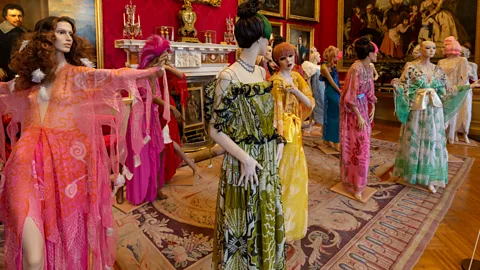 Pete Seaward
Pete SeawardFrom the first ever Barbour jacket to a dress worn by Princess Diana and a velvet smoking cap created for Winston Churchill – the garments that help define British identity are on show in the exhibition Icons of British Fashion at Blenheim Palace.
"Show me the clothes of a country, and I can write its history," the author Anatole France once said. As a cultural identity, "Britishness" is amorphous, and a mass of contradictions – no-nonsense but with a love of pomp; buttoned-up but also rebellious; pragmatic but peacockish; sensible but hedonistic; serious but humorous. The clothes and accessories on display in a new exhibition at Blenheim Palace, Icons of British Fashion, have an inherent connection with the history of "Britishness" – a phrase that means different things to different people, and that is open to endless interpretation, not to mention mythologising.
"A love of storytelling is central to British fashion identity," Amy de la Haye, professor, curator and writer at the London College of Fashion tells the BBC. "This is partly due to the museum visits and fashion history our fashion designers experience at art school. Many of Britain's most innovative designers have a strong sense of history, personal and community identities, landscape, literature and politics. Concept and process are central to their expression."
Of course, it's not all roses and unicorns in the world of British fashion – look no further than the behaviour of designer John Galliano (whose work is also on display in the exhibition).
Here are nine garments from the Icons of British Fashion exhibition that – in one way or another – embody Britishness.
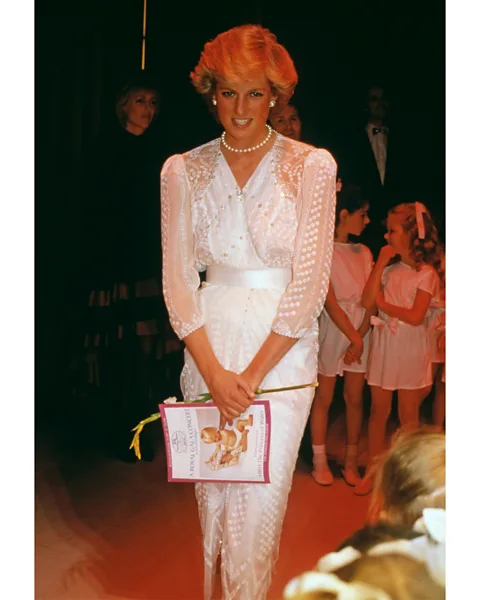 Getty Images
Getty Images1. Princess Diana dress by Zandra Rhodes
The Zandra Rhodes dress worn by the late Princess Diana – to a charity event at the London Palladium in 1987 – is where the rebellious, quirky side of British fashion intersects with the traditional English Rose persona. Rhodes has always loved a narrative, and this particular dress was part of Rhodes's autumn/winter 1985 collection, titled India Revisited. As De la Haye puts it: "Zandra Rhodes communicates the arty, eccentric element of British fashion identity with ethereal garments made from her striking printed silks that tell stories of travel."
There is a tribal element to Britishness, and Diana was always the high-priestess of the Sloane tribe. The white chiffon cocktail dress by Rhodes is quintessentially 1980s – the Sloane Rangers' golden era – and features New Romantic flourishes not dissimilar to her famous wedding dress. With an ivory "buttons and bows" pattern, a cross-over bodice studded with pearl beads and sequins, and a waistband of quilted white satin over a draped skirt, it was a flouncy confection. The whole dress was embellished with pink crystals and white pearlised beads, all applied by hand, giving the outfit an iridescent quality.
Zandra Rhodes is now a Dame, but was seen as rebellious early in her career – the fact that Diana chose to wear her was perhaps an early signal of the Princess's trailblazing, rule-breaking side, which became more apparent in the subsequent decade.
Also displayed at Blenheim are the Summer dresses by Rhodes – worn by the US 70s disco icon Donna Summer. Rhodes also designed the famous white cape for Freddie Mercury, and – by way of contrast – the gown in which Princess Anne announced her engagement to Mark Phillips in 1973. Kate Ballenger, the Keeper of the Palace and Collections at Blenheim, tells the BBC: "Zandra told us how she had come to the Palace for a party in the 70s and saw Mick and Bianca Jagger – Bianca was wearing one of her dresses."
 Terry de Havilland
Terry de Havilland2. Zap Pow shoes by Terry de Havilland
The platform Pop Art-inspired Zap Pow shoes created by Terry de Havilland, and worn by Amy Winehouse on her 2007 international tour, tell a particular story of Britishness. While they reference US artist Roy Lichtenstein, the Zap Pow platform mules nevertheless embody the confident, starry swagger of a particular type of Brit. Liz de Havilland describes her late husband – who died in 2019 – as "a big, warm, lovely geezer from Barking", and tells the BBC how he grew up in a working-class family, and had "learnt to make shoes from his cobbler father, who in the 1940s created wedge-heeled shoes for the showgirls of the Windmill theatre in Soho."
De Havilland’s towering platforms were particularly popular in the showbiz world of the free-wheeling 1970s, and a pair was worn by the iconic character Frank-N-Furter (played by Tim Currie) in 1975 cult classic The Rocky Horror Picture Show. Importantly, De Havilland's extraordinary shoes are known not only for their sex appeal but also their sturdiness. "They are so comfortable and stable, which is why performers like to wear them," his widow explains. There is a poignancy in the fact that the shoes were worn by the swaggering yet vulnerable Winehouse – an iconic figure in British culture who shone brightly during her too-brief life.
 Lulu Guinness
Lulu Guinness3. Flower Pot Primrose Bag by Lulu Guinness
"We are a nation of gardeners, especially famous for rose gardens. It is these that inspired Lulu Guinness to create her glorious flower bucket bags," says De la Haye. Guinness's meticulously constructed Primrose Bag bursts with the exuberance of springtime. The British love of flowers – and the countryside – has been a part of the nation's identity ever since the days of "Merrie England" in early modern Britain – between the Middle Ages and the start of the Industrial Revolution.
Centred around an idyllic pastoral way of life which was thought to be prevalent during this period, the Arcadian notion of a "merrie" countryside has a strongly nostalgic edge, and although it has been idealised, it has nevertheless informed British culture and folkloric celebrations over the centuries. In fact, certain rituals and traditions of Merrie England persist until today. Guinness's flower bag – much like chintz, thatched cottages and scones – exudes a quaint, nostalgic sense of a long-ago Albion.
The Primrose Bag embodies this very British variety of merriness. Guinness – who suffers from depression – told The Guardian how country life, for her, supplies its own cure: "Flowers are my main love. I've always used them to change my mood – flowers have become my therapy."
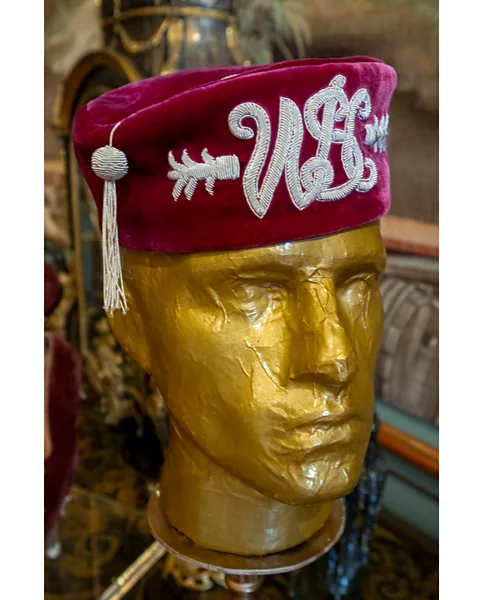 Pete Seaward
Pete Seaward4. Smoking cap by Stephen Jones
The figure of the dandy has a long legacy in Britain. Peacockish and dapper, he is a recurring figure through history, from flamboyant Beau Brummel to dashing Lord Byron – and he is seldom without headgear. Milliner Stephen Jones has created a luxurious, traditional velvet smoking cap for the exhibition as a homage to Winston Churchill, as 2024 marks the 150th anniversary of Churchill's birth at his ancestral home, Blenheim Palace. Churchill was well-known for his dandyish ways, and he favoured flamboyant accessories. He was "both politically and sartorially very confident", says Ballenger. "He was a style icon, and there were deliberate decisions in how he presented himself."
Featuring embroidered initials, button and tassles, the inspiration for Jones's cap was taken from Churchill's red velvet slippers created by Turnbull & Asser. Inside the plush lining, the cap features a hand-embroidered clementine motif in honour of his wife, Clementine. Churchill's mother, Jennie – or Lady Randolph Churchill – who was a US-born heiress, elegant society figure, and one of the first "buccaneers" to cross the ocean, was also an inspiration to her son. "He was in awe of his mother, and thought she was the most glamorous creature in the world," says Ballenger.
From the Pearly Kings and Queens to the 80s Blitz kids, from Peaky Blinders to wedding guests, and from Notting Hill Carnival parade participants to Royal Ascot enthusiasts, headgear has a central role in British culture and life – and, according to Jones, is a very personal statement. He wrote in his book, Hats: An Anthology: "Everyone from showgirls to dictators knows that by wearing a hat they will be the centre of attention... They confer a sense of presence and poise to the wearer that, in my mind, cannot be achieved through clothing or other accessories... The hat's impact is a synthesis of who the person is and who they want to be. When the two are blended together it becomes a great personal signature."
 Pete Seaward
Pete Seaward5. Uncle Harry's Jacket by Barbour
The first ever Barbour coat, named Uncle Harry's Jacket, is about as quintessentially British as it gets. The venerable brand, founded in 1894, was created to make weatherproof workwear for fishermen, and has since become a staple of the British upper-middle-class and upper-class countryside wardrobe. It is a particular favourite with the Royal Family – the late Princess Diana, the late Queen Elizabeth, the Prince and Princess of Wales and His Majesty the King have all worn a Barbour over the years.
"There is a long history with the family [at Blenheim], and some of the staff also wear them," says Ballenger. "The history, the practicality, the craftsmanship is really amazing. When Steve McQueen wore one in the 1960s, the Barbour went mainstream – and then various 'It girls', I suppose you'd call them, started wearing them at Glastonbury, and there was a resurgence." The Barbour has a special connection with Blenheim, she says. "The family have worn Barbours for years, they're part of their heritage. So the Barbour display ties in with both the Palace's history and with fashion, from Uncle Harry's Jacket up to the recent collaborations with Gucci and others."
The Barbour has always been an essentially sustainable garment, adds Ballenger, as a Barbour jacket lasts a lifetime, and is typically repaired many times over – "the Uncle Harry's Jacket on display is still in good condition". And of course there is the great British weather, also a factor in the Barbour’s essential Britishness. As De la Haye points out: "Landscape and climate are central to British fashion identity. As a nation famed for rain, protective clothing is a wardrobe mainstay, with Barbour leading the way in terms of performance and style." Most recently, the Barbour can be seen on screen worn by Eddie Horniman aka "The Duke" (Theo James) in the Guy Ritchie Netflix series The Gentlemen.
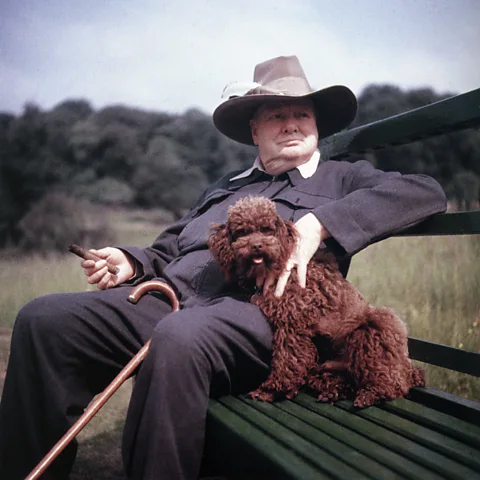 Alamy
Alamy6. Winston Churchill’s siren suit
British identity is hard to pin down – and full of contradictions. There is a traditional perception of Britishness as a "stiff upper lip" mentality, a kind of no-nonsense expediency and realism. Winston Churchill's siren suit, created in the 1930s from an idea by Churchill himself, is the perfect embodiment of the "keep calm and carry on" attitude. It is essentially a practical boiler suit, inspired by labourers' workwear. But adding a contradictory, luxurious twist, Savile Row tailors Turnbull & Asser also created versions for Churchill in both red and green velvet, and equally iconic, monogrammed velvet slippers. The tailor has since created a number of modern versions of the siren suit, on display at Blenheim alongside the original.
Ballenger tells the BBC: "When the air-raid sirens went off, and he had to go to work and be seen in public, he could pop the siren suit on over his pyjamas or whatever he happened to be wearing." Alongside this very British pragmatism, there is also the famous British love of pomp, which Churchill shared. "He had a very particular sense of style – there was often a twist to his outfit and he loved to accessorise. My personal favourite outfit of his is the pin-striped siren suit with animal-print shoes".
 Getty Images
Getty Images7. Propaganda ballgown by Vivienne Westwood
The Propaganda gown of autumn/winter 2005-2006 shows Vivienne Westwood's mastery of exaggerated grandeur and historical reference – in brown silk satin, dramatically corsetted at the waist and with a voluminous skirt. As with all her ballgowns, she plays on ideas of Britishness, and satirises traditional English style with flair and wit. "Iconoclastic" is how De la Haye describes her. From her early days as a young anti-establishment punk, Westwood embodied the kind of disobedient, anarchic, female spirit of Britishness that has a long lineage, from the activists who fought for women’s suffrage to Vita Sackville West in her pearls and trilby hat.
There is a very British humour and irony in Westwood's extraordinary creations – she was the ultimate non-conformist, always contrary, always uncompromising. Once ridiculed, now Queen Viv is viewed as having been right all along – about the climate and about fast fashion. "Buy less, choose well, make it last," was her maxim. As Ballenger puts it: "We couldn't have an 'icons of British fashion' exhibition without Westwood. She was the first designer to highlight important issues. And her work is so beautiful."
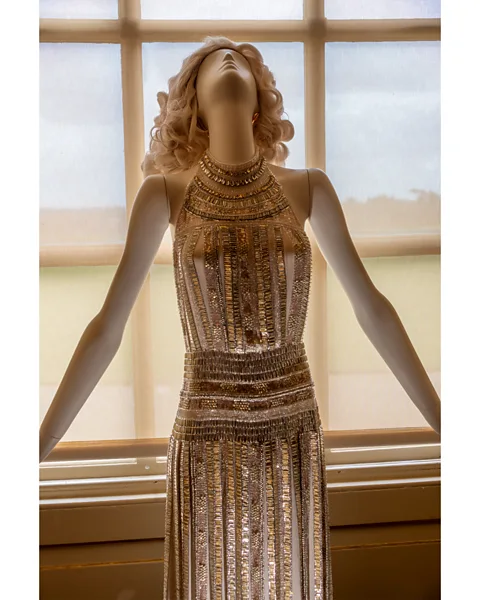 Pete Seaward
Pete Seaward8. Blenheim dress by Alice Temperley
Alice Temperley's dresses are known as the perfect partywear, and the designer's section of the exhibition is a dreamlike Bacchanalian scene, conveying a wild party mood. It captures the traditional British inclination towards hedonism and decadence – recently portrayed in stately-home thriller Saltburn. "The display centres around a hedonistic 'last supper', and it's a central piece," says Ballenger. Specifically created for the exhibition by Temperley is the "Blenheim dress" – which recalls the 20s Flapper look with its narrow, fluid silhouette and its elegant Art Deco-style golden beading. It is a glittering, liquid, iridescent gown – a quintessential party dress that recalls the sybaritic Roaring 20s and evokes a fantastical sense of Jazz Age nostalgia.
"The Blenheim Dress is inspired by the Palace. Everything about it is beautiful – the workmanship, the magical beading – it's breathtaking," says Ballenger. The display is staged with the backdrop of the Victories Tapestries, commissioned by John Churchill, the first Duke of Marlborough, between 1707 and 1717 from the workshop of Judocus de Vos. The tapestries were created to commemorate the battles where Marlborough was victorious during the War of the Spanish Succession – and make a fitting backdrop for the celebratory mood of Temperley's party dress display.
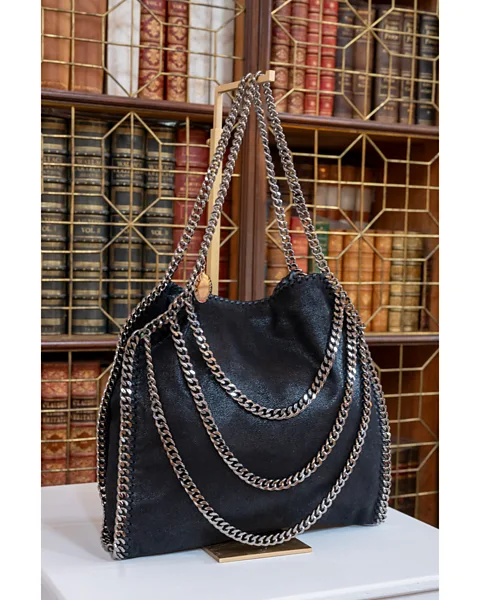 Pete Seaward
Pete Seaward9. Falabella bag by Stella McCartney
Stella McCartney's Falabella bag made its debut in winter 2009, and became the first "It" bag that was made of vegan leather. It embodies the British passion for innovation: handmade cruelty-free in Italy, a conscious rebellion against the belief that luxury bags must be made from leather.
McCartney's innovative spirit makes her an iconic figure in British fashion – and being the daughter of a Beatle seals her pop culture royalty status. "Stella has visited the palace a number of times with friends and family. We're fortunate she's been so supportive, sharing with visitors the innovations and the environmental aspect," says Ballenger. "The Falabella is made from apple peels left over from factories, and the work is about activism and sustainability. It has become the best-selling vegan-leather bag, but also it is iconic and high-end – she's broken all the rules."
--
If you liked this story, sign up for The Essential List newsletter – a handpicked selection of features, videos and can't-miss news delivered to your inbox every Friday.
